Beef Cutting Instructions: A Comprehensive Guide
Mastering beef cutting requires precision and knowledge of primal cuts, tools, and techniques. This guide covers essential tools, proper methods, and common mistakes to avoid, ensuring perfect results.
Understanding the basics of beef cutting is essential for achieving precision and quality. It involves mastering primal cuts, essential tools, and standard methods to ensure optimal results every time.
Understanding the Basics of Beef Cutting
Beef cutting begins with understanding primal cuts like chuck, rib, loin, sirloin, and round. Each section offers unique characteristics, from tender steaks to hearty roasts. Essential tools include sharp knives, saws, and sturdy cutting surfaces. Proper techniques involve slicing against the grain for tenderness and portioning accurately. Knowledge of beef anatomy ensures efficient use of the carcass, minimizing waste. By mastering these fundamentals, you can achieve consistent results, whether preparing steaks, roasts, or ground beef, ensuring quality and flavor in every cut.
Importance of Proper Cutting Techniques
Proper cutting techniques are crucial for achieving tender and flavorful beef. Incorrect methods can result in tough meat or uneven portions, affecting the overall dining experience. Precision in slicing and portioning ensures consistency, while maintaining hygiene prevents contamination. Sharp tools and safe handling are essential to avoid accidents. By adhering to best practices, you preserve the quality of the beef, making every cut enjoyable and satisfying; Proper techniques also minimize waste, ensuring maximum value from each primal section, and allow for optimal cooking methods tailored to specific cuts.
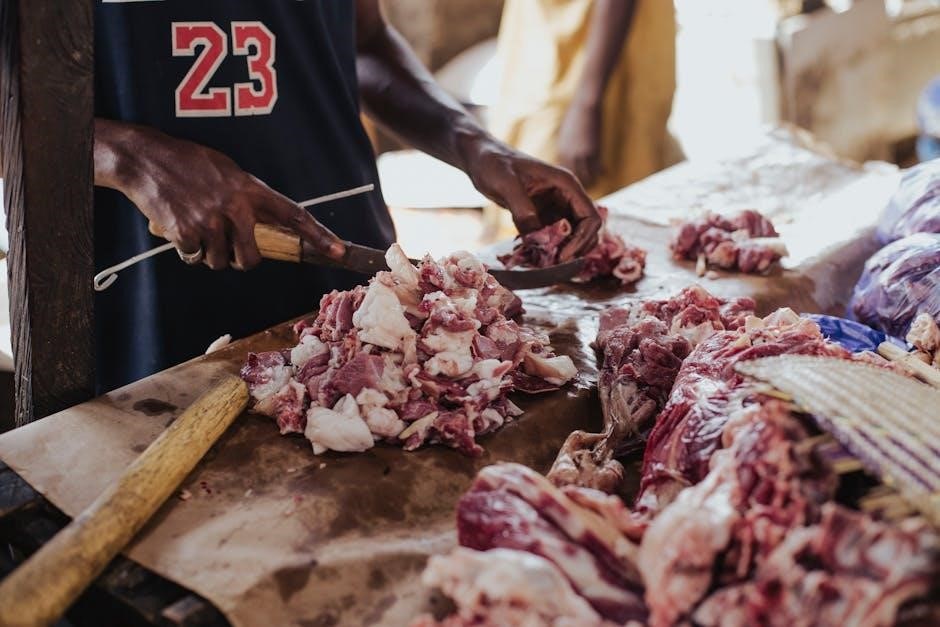
Understanding the Anatomy of a Beef Carcass
A beef carcass is divided into primal cuts, such as Chuck, Rib, Loin, Sirloin, and Round. These sections are further split into sub-primal and retail cuts for specific uses.
Primary Cuts of Beef: Primal, Sub-Primal, and Retail Cuts
Primary beef cuts are categorized into primal, sub-primal, and retail cuts; Primal cuts, such as Chuck, Rib, and Loin, are the initial divisions of the carcass. These are further divided into sub-primal cuts, like flank steak or short ribs. Retail cuts, the final products for consumers, include steaks, roasts, and ground beef. Each level of cutting refines the beef for specific culinary uses, ensuring optimal tenderness and flavor in various dishes.
Identifying Key Sections: Chuck, Rib, Loin, Sirloin, and Round
The Chuck, located near the shoulder, offers hearty, flavorful cuts like ground beef and roasts. The Rib section, near the spine, is known for its rich, tender steaks and roasts. The Loin, along the back, provides some of the most tender cuts, such as filet mignon and porterhouse steaks. The Sirloin, closer to the hip, offers leaner cuts ideal for steaks and roasts. Finally, the Round, from the hindquarters, is lean and often used for roasts or steaks like round tip; Each section’s unique characteristics make them suited for specific culinary uses.
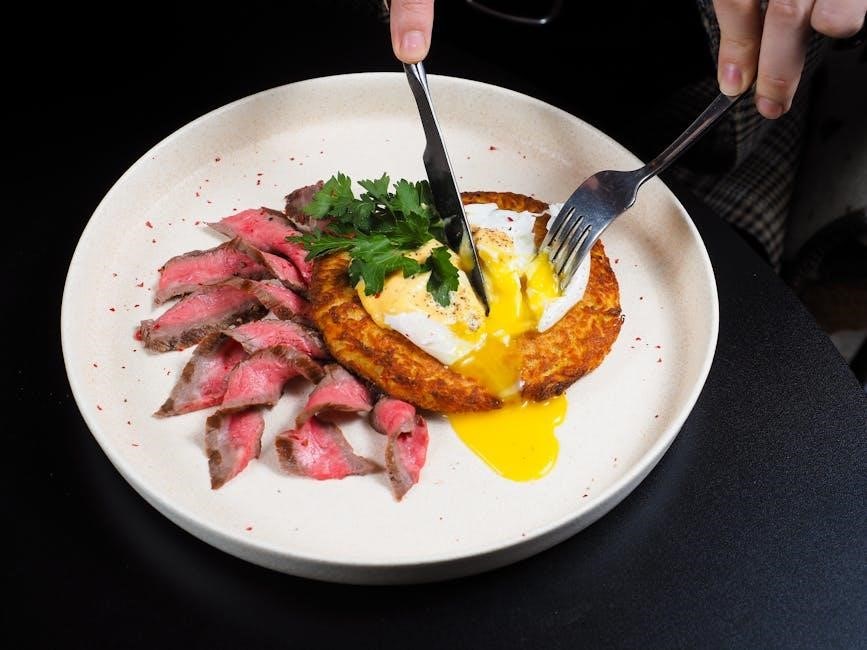
Essential Tools and Safety Tips for Beef Cutting
Sharp knives, sturdy saws, and sanitized cutting surfaces are vital for precise cuts. Always handle sharp tools with care, wear gloves, and maintain strict hygiene standards to ensure safety.
Mandatory Tools for Beef Cutting: Knives, Saws, and Cutting Surfaces
Knives are the backbone of beef cutting, with boning knives and chef knives being essential for precision. Saws, such as meat saws, are crucial for dividing large primal cuts. A sturdy cutting surface, like a butcher block, ensures stability and hygiene. These tools are indispensable for achieving clean, accurate cuts. Proper maintenance and sharpening of knives and saws are vital for efficiency and safety. Always use high-quality equipment to handle beef effectively and maintain professional results in every cut.
Safety Precautions: Handling Sharp Objects and Maintaining Hygiene
Safety is paramount in beef cutting; Always handle sharp knives and saws with care, using cut-resistant gloves if needed. Ensure a clean workspace by sanitizing tools and surfaces regularly. Proper hygiene prevents contamination and ensures quality. Keep loose clothing tied back and avoid distractions while cutting. Store tools securely to prevent accidents. Following these precautions guarantees a safe and efficient cutting process, protecting both the individual and the meat from harm. Prioritizing safety maintains professionalism and integrity in every step of beef preparation.
Primary Beef Cuts: A Detailed Overview
Primary beef cuts include chuck, rib, loin, sirloin, and round. Each offers unique qualities, from tender steaks to hearty roasts, catering to diverse culinary preferences and needs.
Chuck: Versatile Cuts for Ground Beef and Roasts
The chuck section, located near the shoulder, is a versatile cut ideal for both ground beef and roasts. It contains a good balance of fat and lean meat, making it perfect for juicy burgers and flavorful roasts. Popular chuck cuts include the chuck roast and chuck steaks, which are great for slow-cooking methods like braising or roasting. Ground beef from the chuck is often preferred for its rich flavor and tender texture, making it a staple in many kitchens. Proper trimming ensures optimal results.
Rib: Premium Cuts for Steaks and Roasts
The rib section is renowned for its premium cuts, offering exceptional tenderness and flavor. Ribeye steaks, a favorite among steak lovers, are derived from this area, known for their rich marbling, which enhances juiciness and taste. Rib roasts are equally prized, delivering hearty, flavorful meals when slow-cooked. The rib’s fatty content ensures succulent results, making it ideal for both steaks and roasts. Proper cutting techniques preserve the natural tenderness, while trimming excess fat can tailor the cut to suit various preferences and cooking methods.
Loin: Tender Cuts for Steaks and Roasts
The loin is a prime section, yielding some of the most tender and sought-after beef cuts. It is divided into the short loin and sirloin, each offering distinct cuts. The short loin provides iconic steaks like the Porterhouse and T-bone, celebrated for their rich flavor and buttery texture. Sirloin cuts are equally popular, offering a leaner option without compromising on taste. Loin roasts are perfect for special occasions, delivering a tender and juicy experience. Proper trimming and portioning ensure these cuts meet high culinary standards, making them ideal for grilling or roasting.
Sirloin: Lean Cuts for Steaks and Roasts
The sirloin is a lean yet flavorful section, offering a variety of cuts ideal for both steaks and roasts. It is divided into the top sirloin and bottom sirloin, with the top sirloin being more tender and commonly used for steaks. Sirloin steaks are often boneless and known for their robust beefy flavor. Roasts from this section are perfect for slow cooking, yielding a tender and juicy result. Sirloin cuts are versatile, making them suitable for grilling, pan-searing, or oven roasting, and they pair well with a range of seasonings and marinades to enhance their natural taste.
Round: Lean Cuts for Steaks and Roasts
The round is a lean cut from the hindquarters, known for its lower fat content and firm texture. It is often divided into the top round, bottom round, and eye of round. Top round steaks are tender and ideal for grilling or pan-searing, while bottom round is commonly used for roasts or deli meats. Eye of round is a popular choice for roasts, offering a delicate flavor when cooked low and slow. Round cuts are perfect for those seeking leaner options and are often thinly sliced for dishes like Carne Asada, ensuring a flavorful yet healthier beef experience.
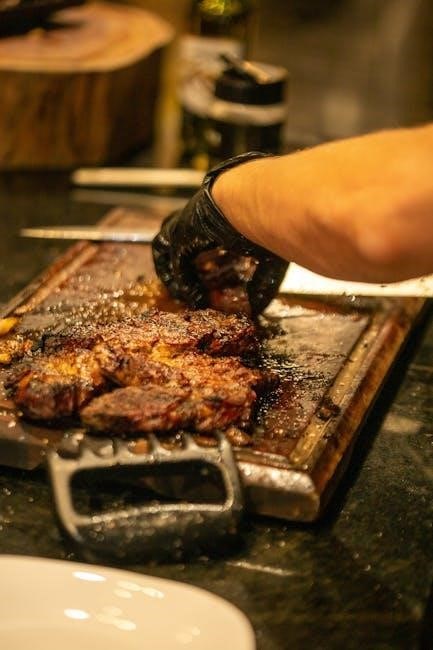
Sub-Primal and Retail Beef Cuts
Sub-primal cuts are broken into retail cuts like Ribeye, Sirloin, T-Bone, and Filet Mignon. These are portioned into steaks of varying thickness and packaged for convenience.
Breaking Down Sub-Primal Cuts into Retail Cuts
Sub-primal cuts are divided into retail cuts through precise trimming and portioning. For instance, the rib sub-primal is cut into Ribeye steaks, while the loin is divided into T-Bone and Porterhouse. Each cut is tailored to specific thickness and weight specifications, ensuring consistency in portion sizes. This process involves skilled knife work and understanding of muscle structure to maximize tenderness and flavor. Retail cuts are then packaged, often vacuum-sealed, to maintain freshness and cater to consumer preferences.
Popular Retail Cuts: Ribeye, Sirloin, T-Bone, and Filet Mignon
Ribeye, known for its marbling, offers rich flavor and tenderness. Sirloin, leaner, is ideal for grilling. T-Bone combines sirloin and tenderloin for a hearty meal. Filet Mignon, from the tenderloin, is the most tender cut, perfect for special occasions. Each cut is portioned to meet consumer preferences, ensuring quality and consistency in every steak.
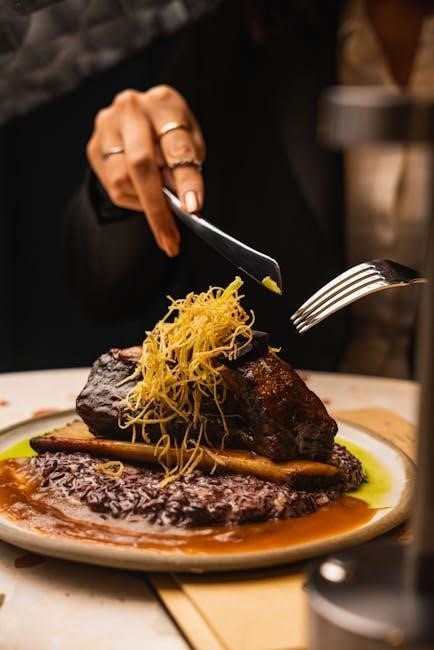
Ground Beef and Trim Options
Ground beef is customized by trim and fat content, offering options for lean or regular mixes. Trim options enhance flavor and texture, ensuring desired consistency in every batch.
Understanding Ground Beef Production
Ground beef production involves grinding primal cuts like chuck or round into fine texture. Fat content is adjustable, with lean options using 90% lean meat and regular at 70-80%. Additives like salt enhance flavor. Packaging choices include butcher wrap or vacuum-sealing for freshness. Portion sizes vary, with 1-2 lbs per package. Proper handling ensures safety and quality, making ground beef versatile for various dishes. Customization allows tailoring to dietary preferences, ensuring each batch meets specific taste and texture requirements.
Trim and Fat Content Options for Custom Ground Beef
Customizing ground beef involves selecting trim levels and fat content. Lean options use 90% lean meat, while standard mixes are 70-80% lean. Adjusting fat content affects juiciness and flavor. Trim options include cutting primal sections like chuck or round. For added richness, some prefer higher fat, while others opt for leaner mixes. Seasonings or additives can enhance taste. Packaging choices like butcher wrap or vacuum-sealing maintain freshness. Portion sizes range from 1-2 lbs, allowing versatility in meal planning. Tailoring these options ensures ground beef meets specific taste and dietary needs effectively.
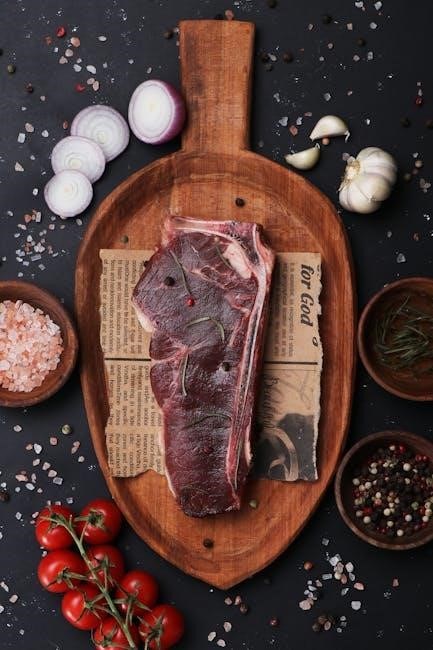
Beef Cutting Instructions for Specific Cuts
Steaks are cut to desired thickness, while roasts are portioned by weight. Short ribs, brisket, and tri-tip are trimmed for optimal tenderness and flavor in specific dishes.
Steak Cutting: Thickness and Portion Sizes
Steaks are typically cut to 3/4-inch thickness for optimal grilling or pan-searing. Portion sizes vary, with 6-8 ounces per steak being standard. Ribeye, sirloin, and T-bone steaks are popular choices, often cut bone-in or boneless. For thicker cuts, 1-1.5 inches is recommended. Customizing portion sizes ensures each steak meets individual preferences. Proper cutting techniques, like slicing against the grain, enhance tenderness and flavor. Clear instructions for thickness and portion sizes help butchers deliver consistent, high-quality results tailored to specific needs.
Roast Cutting: Size and Weight Specifications
Roasts are typically cut to 3-4 pounds each, ensuring even cooking and generous portions. Popular cuts like chuck, rib, and rump roasts are common choices. For larger gatherings, 4-5 pound roasts are recommended. Uniform sizing ensures consistent cooking results. Customers often opt for 3-pound roasts for balance between flavor and serving size. Clear size specifications help butchers prepare roasts that meet individual needs, whether for family meals or special occasions. Proper sizing enhances both presentation and cooking efficiency, making it a key consideration in beef cutting instructions.
Other Cuts: Short Ribs, Brisket, and Tri-Tip Roast
Short ribs are ideal for hearty stews or braises, offering rich flavor when slow-cooked. Brisket, a tougher cut, requires low-and-slow cooking to achieve tender results. Tri-tip roast, a triangular cut, is perfect for roasting or grilling, delivering bold flavor. These cuts are popular for their versatility and ability to enhance various dishes. Proper portioning and cooking techniques ensure optimal results, making them favorites for both home cooks and professional chefs.
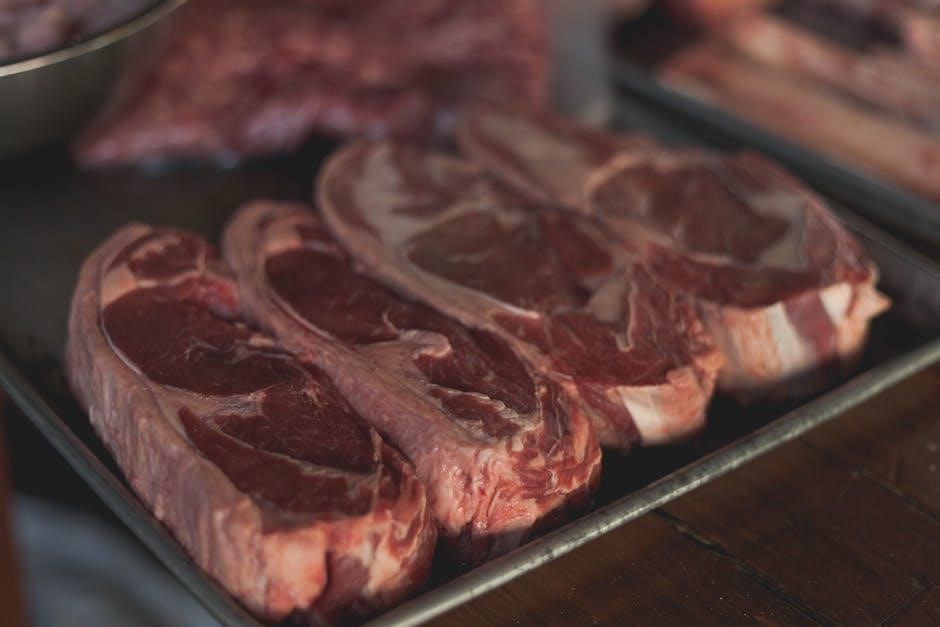
Cooking Methods for Different Beef Cuts
Grilling, pan-searing, and oven roasting are popular for steaks and roasts. Lean cuts thrive with moisture-retentive methods, while fatty cuts caramelize beautifully under high heat, enhancing flavor.
Grilling, Pan-Sealing, and Oven Roasting Techniques
Grilling enhances beef’s smoky flavor, ideal for steaks and roasts. Pan-searing creates a crust, locking juices for tender results. Oven roasting is perfect for larger cuts, ensuring even cooking. Proper seasoning and timing are key for each method, while lean cuts benefit from marinades to stay moist. High heat searing followed by lower temperatures ensures optimal doneness, preserving texture and flavor in every bite. These techniques highlight the versatility of beef, catering to various preferences and cut types. Always slice against the grain for the best dining experience.
Recommended Cooking Methods for Lean vs. Fatty Cuts
Lean beef cuts, like sirloin and round, are best suited for grilling or pan-searing to retain moisture and tenderness. Fatty cuts, such as ribeye or brisket, benefit from slow-cooking methods like braising or oven roasting to break down connective tissues. Grilling lean cuts at high heat ensures a crispy crust, while fatty cuts thrive in lower, longer cooking processes. Matching the right technique to the cut ensures optimal flavor and texture, whether you prefer a juicy steak or a rich, fall-apart roast.
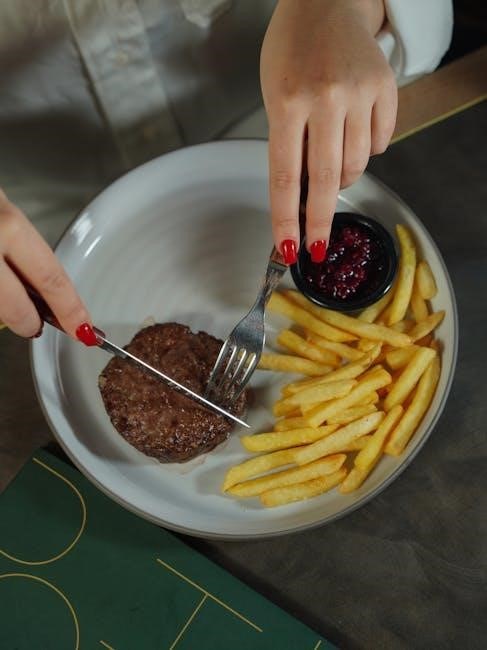
Working with a Butcher: Tips and Recommendations
Communicate your preferences clearly, ensuring custom cuts and packaging meet your needs. Ask about options like bone-in steaks or vacuum-sealed packaging for freshness and convenience.
Communicating Your Cutting Preferences Effectively
Clear communication with your butcher ensures your beef is cut exactly to your liking. Specify steak thickness, portion sizes, and whether you prefer bone-in or boneless cuts. For roasts, indicate desired weight and type, such as chuck or rib. Ground beef preferences should include lean-to-fat ratios and packaging options like butcher wrap or vacuum sealing. Providing detailed instructions helps avoid misunderstandings and guarantees satisfaction with the final product.
Understanding Butcher Wrap vs. Vacuum Sealed Packaging
Butcher wrap and vacuum-sealed packaging offer different benefits for beef storage. Butcher wrap allows the meat to breathe, preventing moisture buildup and preserving flavor, ideal for short-term use. Vacuum sealing removes air, preventing oxidation and extending shelf life, perfect for freezing. Choose based on storage duration and personal preference to maintain beef quality and freshness. Both methods ensure your cuts remain in prime condition for cooking.
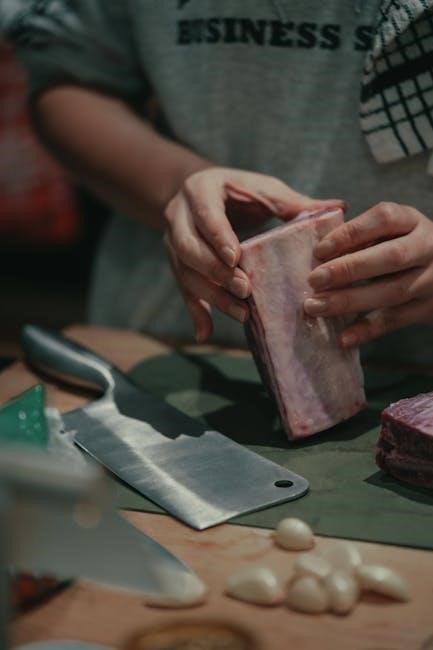
Common Mistakes to Avoid in Beef Cutting
Over-tenderizing, incorrect steak thickness, and improper knife handling are common errors. Ensure precise cuts and avoid rushing to maintain meat quality and safety during processing.
Over-Tenderizing or Under-Tenderizing Meat
Tenderizing meat incorrectly can significantly affect its quality. Over-tenderizing breaks down too much muscle, making meat mushy, while under-tenderizing leaves it tough. Proper tenderizing enhances texture without compromising structure. Using tools like meat mallets or enzymatic tenderizers requires careful timing. Over-tenderizing can also release excess moisture, leading to a less flavorful product. It’s crucial to balance tenderization to maintain the meat’s natural texture and juiciness. Always follow recommended tenderizing times and methods to achieve optimal results for steaks, roasts, and other cuts.
Incorrect Steak Thickness and Portion Sizes
Steak thickness and portion sizes are critical for even cooking and customer satisfaction. Cutting steaks too thin can lead to overcooking, while overly thick steaks may not cook evenly. Standard thicknesses range from 3/4 to 1 inch, depending on the cut. Portion sizes should balance serving needs without excess. Incorrect sizing can result in inconsistent dining experiences. Ensuring uniformity in both thickness and portion size is key to delivering high-quality steaks every time, whether for home or commercial use. Proper sizing enhances flavor, texture, and overall satisfaction.
How to Fill Out a Beef Cut Sheet
Filling out a beef cut sheet requires clear instructions on cuts, portion sizes, and packaging. Specify roast weights, steak thickness, and ground beef preferences for accurate processing.
Step-by-Step Guide to Completing a Cut Sheet
Begin by selecting roast sizes, typically 2.5-3 lbs, and choose between bone-in or boneless steaks. Specify steak thickness and the number per package. Indicate ground beef preferences, such as lean or regular, and portion sizes. For each primal cut, decide allocations for steaks, roasts, or ground beef. Note any additional requests like soup bones or stew meat. Ensure all sections are filled to avoid default processing. Review and confirm instructions with your butcher to ensure accuracy and meet your expectations.
Key Considerations for Portion Sizes and Preferences
When completing a cut sheet, consider how many steaks per package suit your needs, typically 2-4. Steak thickness is crucial, with options like 3/4″ or custom sizes. For ground beef, choose between regular, lean, or custom fat content. Specify roast sizes, usually 2.5-3 lbs, and opt for bone-in or boneless cuts. Ensure allocations for items like soup bones or stew meat. Clearly communicate preferences to avoid defaults, as each primal cut impacts final yields. This ensures your beef is processed to your liking, balancing convenience and customization for optimal enjoyment.

Sustainability and Beef Cutting
Sustainability in beef cutting involves minimizing waste and reducing environmental impact through efficient techniques and responsible practices, ensuring eco-friendly beef processing always.
Minimizing Waste in Beef Cutting
Minimizing waste in beef cutting involves careful planning and precision to utilize every part of the carcass. This includes using trim for ground beef, soup bones, and stew meat. Proper techniques ensure that less is discarded, reducing environmental impact. Butchers and home processors can adopt strategies like portion control and efficient trimming to maximize yield. Additionally, bones and fat can be repurposed for stock or rendering, further reducing waste. Sustainable practices not only benefit the environment but also enhance the overall value of the beef.
Environmental Impact of Beef Production and Cutting
Beef production and cutting have significant environmental implications, including greenhouse gas emissions, water usage, and land degradation. Cattle farming contributes to methane production, a potent greenhouse gas, and requires substantial resources for feed and water. Additionally, improper cutting and waste disposal can lead to environmental contamination. Sustainable practices, such as minimizing waste and adopting efficient cutting techniques, can reduce the ecological footprint. Awareness and responsible processing help mitigate these impacts while preserving resources for future generations.
Modern Trends in Beef Cutting
Modern beef cutting emphasizes precision, customization, and sustainability. Techniques include advanced knife skills, portion control, and minimal waste. Innovations like vacuum sealing and pre-packaging enhance convenience and freshness.
Popular Cutting Techniques and Innovations
Modern beef cutting incorporates advanced techniques like precision knife skills, portion control, and minimal waste strategies. Innovations such as vacuum sealing and pre-packaging enhance freshness and convenience. Instructional guides and videos now offer step-by-step tutorials for fabricated cuts, like the Denver Cut and Flat Iron Steak. These methods emphasize sustainability and customization, allowing consumers to tailor their beef to specific preferences. By combining traditional craftsmanship with modern tools, these techniques ensure high-quality, consistent results for both home cooks and professional butchers.
Customization Options for Beef Cutting
Beef cutting allows for extensive customization to meet individual preferences. Consumers can specify steak thickness, portion sizes, and whether steaks are bone-in or boneless. Roasts can be sized by weight, and ground beef can be tailored to desired lean-to-fat ratios. Additionally, options like tenderizing, trimming, and packaging preferences (e.g., butcher wrap or vacuum-sealed) provide further personalization. Clear cutting instructions ensure that the final product aligns with the customer’s needs, making it easy to enjoy beef exactly how it’s wanted for various cooking methods and meal plans.







